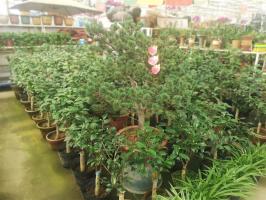How to Keep a Hyacinth as a Potted Plant
Hyacinths are beautiful plants that are known for their fragrant blooms and vibrant colors. Keeping a hyacinth as a potted plant can be a wonderful way to brighten up your home, but it's important to know how to properly care for these delicate plants. In this article, we'll discuss some tips for keeping your hyacinth healthy and thriving.
Choosing the Right Pot
The first step in keeping a hyacinth as a potted plant is choosing the right pot. Hyacinths need a pot that is deep and wide enough to accommodate their bulbs, roots, and foliage. Ideally, the pot should be about 6 inches deep and 8 inches wide. It's also important to choose a pot with drainage holes to prevent the soil from becoming waterlogged.
Planting Your Hyacinth
Once you've chosen your pot, you can begin planting your hyacinth. Fill the pot with a loose, well-draining potting mix. Place the hyacinth bulb in the center of the pot with the narrow end facing upward. Cover the bulb with soil, leaving the top of the bulb exposed. Water the soil until it's moist but not soaking wet.
Providing the Right Environment
Hyacinths thrive in cool, bright environments. Keep your potted hyacinth in a location that receives plenty of indirect sunlight, such as a windowsill or a porch. The ideal temperature for a hyacinth is between 50 and 60 degrees Fahrenheit. Keeping your hyacinth in a cooler room or near a drafty window can help replicate these conditions.
Watering Your Hyacinth
Proper watering is essential for the health of your hyacinth. Water your hyacinth once a week, or whenever the top inch of soil feels dry to the touch. Avoid overwatering, as too much water can cause the bulb to rot. Be sure to water the soil, not the bulb itself.
Fertilizing Your Hyacinth
Hyacinths don't require a lot of fertilizer, but adding a small amount can help promote healthy growth and flowering. You can fertilize your hyacinth once a month with a balanced fertilizer, such as a 10-10-10 or 20-20-20 formula. Be sure to follow the instructions on the fertilizer package for best results.
Taking Care of Your Hyacinth After Blooming
Once your hyacinth has finished blooming, it will enter a dormant phase. At this point, you can either discard the plant or try to keep it for next year. If you choose to keep your hyacinth, stop watering it and allow the foliage to die back naturally. Once the foliage has dried up, remove the bulb from the soil and store it in a cool, dry location. You can replant the bulb in the fall for blooms next spring.
Conclusion
Keeping a hyacinth as a potted plant can be a rewarding and beautiful addition to your home. By following these tips for proper care and maintenance, you can help your hyacinth thrive and produce vibrant, fragrant blooms.

 how many times do yo...
how many times do yo... how many planted tre...
how many planted tre... how many pine trees ...
how many pine trees ... how many pecan trees...
how many pecan trees... how many plants comp...
how many plants comp... how many plants can ...
how many plants can ... how many plants and ...
how many plants and ... how many pepper plan...
how many pepper plan...
































